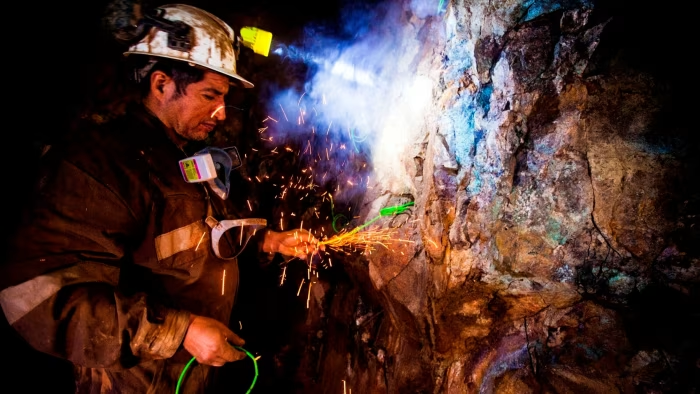As we move into 2025, global industries are undergoing significant transformations driven by technological advancements, environmental changes, and shifting consumer demands. Among the key factors shaping these changes are commodities—the raw materials and goods that fuel economies, manufacturing, and trade. With the increasing importance of sustainability, renewable energy, and digitalization, certain commodities are poised to have a disproportionate impact on global industries in the coming years.
In this blog, we’ll explore the top 5 commodities that are expected to be pivotal to the future of global industries by 2025, highlighting their influence on everything from renewable energy to advanced technology and infrastructure development.

1. Lithium: Fueling the Electric Revolution
Why Lithium Is Important:
Lithium, a critical component in rechargeable batteries, is one of the most important commodities shaping the future of global industries. As the world moves toward electrification, lithium’s role in powering electric vehicles (EVs), energy storage systems, and mobile devices has skyrocketed. With governments globally setting ambitious targets for carbon neutrality and accelerating the adoption of electric transportation, lithium is becoming the backbone of the clean energy revolution.
Key Impacts in 2025:
- Electric Vehicles (EVs): Lithium-ion batteries are essential for powering electric vehicles. With the global electric vehicle market expected to grow rapidly in the coming years, demand for lithium is set to increase substantially. According to some forecasts, EV sales will represent over 30% of all car sales by 2025, directly driving up the need for lithium.
- Energy Storage Systems: Lithium-ion batteries are also key in storing energy generated from renewable sources like solar and wind. As the world increasingly adopts renewable energy, the demand for large-scale energy storage systems will fuel further lithium demand.
- Battery Recycling: By 2025, the lithium market is expected to see a significant push for recycling technologies, which will help mitigate some of the challenges surrounding raw material extraction and provide a more sustainable supply chain.
Challenges:
While lithium has immense growth potential, issues such as supply chain bottlenecks, environmental concerns about mining practices, and geopolitical risks in major lithium-producing countries (like Chile and Australia) may impact its availability and price stability.
2. Copper: The Heart of Infrastructure and Green Tech
Why Copper Is Important:
Copper is known for its excellent electrical conductivity, making it indispensable in nearly every aspect of modern infrastructure, electronics, and energy. From power grids to electric vehicles, copper is essential for transmitting energy efficiently and powering cutting-edge technologies. As we look toward 2025, copper’s role in the global economy is expected to expand, driven by the global push toward renewable energy, urbanization, and digitalization.
Key Impacts in 2025:
- Renewable Energy Infrastructure: Copper is a critical material for wind and solar power installations, electric grids, and charging stations for electric vehicles. The transition to renewable energy will drive higher demand for copper in the construction of clean energy systems.
- Electric Vehicles: EVs require significantly more copper than traditional gasoline-powered vehicles. For instance, an electric vehicle typically uses three to four times the amount of copper than a regular car. As the global automotive industry shifts towards electric mobility, copper demand will continue to rise.
- 5G and Digitalization: The expansion of 5G networks and the rise of Internet of Things (IoT) devices will also increase copper demand, as these technologies require high-performance wiring and infrastructure.
Challenges:
The copper industry faces challenges related to supply chain constraints, rising extraction costs, and the environmental impact of mining. There is also growing concern about the geopolitical concentration of copper production, which could lead to supply disruptions.
3. Rare Earth Elements (REEs): Enabling Technological Advancements
Why Rare Earth Elements Are Important:
Rare earth elements (REEs) are a group of 17 chemical elements that are essential for the production of high-tech devices, including smartphones, electric vehicles, wind turbines, and military equipment. Despite their name, REEs are not necessarily rare, but they are often difficult and costly to extract in environmentally responsible ways. As the world moves toward more advanced and energy-efficient technologies, the demand for REEs is set to grow exponentially by 2025.
Key Impacts in 2025:
- Electric Vehicles: REEs such as neodymium and dysprosium are used in magnets that power electric vehicle motors. The global shift towards EVs will significantly increase the demand for these elements.
- Renewable Energy: Many clean energy technologies, particularly wind turbines, rely on rare earths for efficient energy conversion. The move toward a green economy will drive demand for REEs in wind power generation and energy storage systems.
- Smart Technology: Smartphones, tablets, computers, and other smart devices require small quantities of REEs in components like screens, batteries, and speakers. As global demand for these devices continues to grow, so too will the demand for REEs.
Challenges:
One of the biggest challenges facing the REE market is its heavy reliance on China, which controls about 70% of global rare earth production. This dependence creates supply chain vulnerabilities and geopolitical risks for other nations.
4. Natural Gas: The Bridge Fuel to a Low-Carbon Future
Why Natural Gas Is Important:
Natural gas is often referred to as a “bridge fuel” because it emits less carbon dioxide than coal and oil when burned for energy, making it an important transitional energy source as countries work to reduce their greenhouse gas emissions. While the world increasingly moves towards renewable energy, natural gas remains an integral part of global energy systems due to its role in providing reliable, flexible power generation.
Key Impacts in 2025:
- Energy Transition: While renewable energy is expected to dominate in the long run, natural gas will continue to play a crucial role in stabilizing the energy grid. It is particularly valuable in regions where solar and wind energy are intermittent.
- Liquefied Natural Gas (LNG): The growth of LNG infrastructure and international trade will enable natural gas to be a global commodity, especially in regions such as Asia, where it is replacing coal as a power generation source.
- Decarbonization Efforts: Many countries are using natural gas as a cleaner alternative to coal for electricity generation. This trend will continue as nations like India and China seek to reduce emissions while still meeting growing energy demands.
Challenges:
The ongoing decarbonization efforts and the rise of renewable energy may limit natural gas demand in the long term. Additionally, geopolitical tensions in key natural gas-producing regions, like Russia and the Middle East, could impact global supply.
5. Timber: A Sustainable Building Block for Green Infrastructure
Why Timber Is Important:
Timber is not only one of the oldest and most versatile building materials, but it is also emerging as a key player in the transition to sustainable construction. With the global construction sector contributing a significant portion of carbon emissions, the shift towards sustainable and eco-friendly building materials is more urgent than ever. Timber, as a renewable resource, is increasingly seen as a critical component in the construction of energy-efficient buildings, green infrastructure, and urban development.
Key Impacts in 2025:
- Sustainable Building Materials: Timber is gaining popularity in the construction industry, especially in the form of cross-laminated timber (CLT), which is used in skyscrapers and large commercial buildings. Timber has a smaller carbon footprint than traditional concrete and steel, making it a popular choice for architects aiming to reduce the environmental impact of their projects.
- Carbon Sequestration: Trees naturally absorb carbon dioxide, and when used in construction, timber stores that carbon, helping to offset emissions. This “carbon sink” effect makes timber an attractive material for building environmentally friendly infrastructure.
- Green Urbanization: With urbanization on the rise, sustainable cities are increasingly focusing on using eco-friendly materials like timber to create energy-efficient buildings and urban spaces that reduce their overall environmental impact.
Challenges:
Sustainably sourcing timber while preserving forests and biodiversity remains a challenge. There are concerns about illegal logging, deforestation, and the ecological impact of large-scale timber extraction, which has led to the establishment of certification bodies like FSC (Forest Stewardship Council) to ensure responsible sourcing.
Conclusion
As we approach 2025, the global commodities market will undergo significant shifts, driven by advancements in technology, the need for sustainable practices, and the transition to a low-carbon economy. The commodities mentioned above—lithium, copper, rare earth elements, natural gas, and timber—are expected to have a profound impact on industries ranging from automotive and energy to construction and technology.
While these commodities present enormous opportunities for innovation and growth, they also come with challenges, including supply chain risks, geopolitical factors, and sustainability concerns. Businesses and governments will need to adopt forward-thinking strategies to manage these challenges and ensure that the benefits of these commodities are realized in a way that supports long-term global economic growth and environmental sustainability.
The next decade will be critical for how these commodities are sourced, utilized, and integrated into global industries, setting the stage for a more sustainable, digital, and energy-efficient future.

